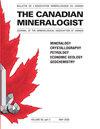阿根廷圣克鲁斯Cerro Moro矿床Escondida浅成热液脉中的含银和含Au相
IF 1.5
4区 地球科学
Q3 MINERALOGY
引用次数: 2
摘要
Cerro Moro矿床位于阿根廷南部圣克鲁斯省,南48°5′55〃,西66°39′1.6〃,海拔100米。它是一种低硫化Au-Ag浅成热液矿化,由大量NW–SE结构控制的石英脉承载,在空间和时间上与侏罗纪伸展和岩浆作用的产物非常接近。Escondida矿脉是最重要的矿化结构,因为它含有富含贱金属和Au-Ag的高品位矿化。在该矿脉和Zoe矿脉中,矿石矿物丰富(闪锌矿、方铅矿、黄铜矿、棘铁矿,以及不太丰富的黄铁矿和水铝石),通常与具有块状、多孔、硬壳状和带状结构的深灰色细粒石英有关;局部存在数量不等的细粒白云母薄片。含Ag和Au的矿物组合以棘铁矿、银铁矿、多碱土矿、泥炭岩、铁镁矿、麦肯锡矿和胡椒石为代表。丰富的棘铁矿通常与金和银伴生;检测到铜富集,并将其解释为含铜矿物的纳米包裹体。富含Se和Te的矿物(棘铁矿、银铁矿、多碱土矿、磷铁矿、锶铁矿和麦肯锡矿)的出现,而不是硒化银和/或碲化物的出现,表明矿化流体减少,并可归因于Se或Te对S的部分取代。根据它们的化学性质,可以区分多碱土矿和泥炭石。尽管含银磺盐的浅成热液矿床中存在的银矿相对常见,但在Cerro Moro中首次提到这一点对锗的勘探是非常令人鼓舞的,锗是一种关键元素,美国和中国等国也认为锗具有战略意义。本文章由计算机程序翻译,如有差异,请以英文原文为准。
The Ag- and Au-bearing phases in the Escondida epithermal vein, Cerro Moro deposit, Santa Cruz, Argentina
The Cerro Moro deposit is located at 48°5′55″S, 66°39′1.6″W and 100 m.o.s.l. in Santa Cruz province, southern Argentina. It is a low sulfidation Au-Ag epithermal mineralization hosted by numerous NW–SE structurally controlled quartz veins developed in close spatial and temporal proximity to the products of Jurassic extension and magmatism. The Escondida vein is the most significant mineralized structure, as it hosts the base metal-rich and Au-Ag high grade mineralization. In this vein and the Zoe ore-shoot, ore minerals are abundant (sphalerite, galena, chalcopyrite, acanthite, and less abundant pyrite and marcasite) and frequently related to dark grey, fine-grained quartz with massive, porous, crustiform, and banded textures; variable quantities of fine-grained flakes of muscovite are locally present. The Ag- and Au-bearing mineral association is represented by acanthite, argyrodite, polybasite, pearceite, stromeyerite, mckinstryite, and jalpaite. Abundant acanthite occurs commonly associated with gold and silver; copper enrichments were detected and interpreted as nanoinclusions of Cu-bearing minerals. The occurrence of Se- and Te-enriched minerals (acanthite, argyrodite, polybasite, pearceite, stromeyerite, and mckinstryite), rather than silver selenides and/or tellurides, indicates the presence of reduced mineralizing fluids and may be ascribed to partial substitution of S by Se or Te. Polybasite and pearceite were differentiated by their chemistry. Although the presence of argyrodite in epithermal deposits with silver sulfosalts is relatively common, this first mention in Cerro Moro is highly encouraging for exploration for germanium, a critical element, which is also considered strategic by countries such as the USA and China.
求助全文
通过发布文献求助,成功后即可免费获取论文全文。
去求助
来源期刊

Canadian Mineralogist
地学-矿物学
CiteScore
2.20
自引率
22.20%
发文量
45
审稿时长
4-8 weeks
期刊介绍:
Since 1962, The Canadian Mineralogist has published papers dealing with all aspects of mineralogy, crystallography, petrology, economic geology, geochemistry, and applied mineralogy.
 求助内容:
求助内容: 应助结果提醒方式:
应助结果提醒方式:


